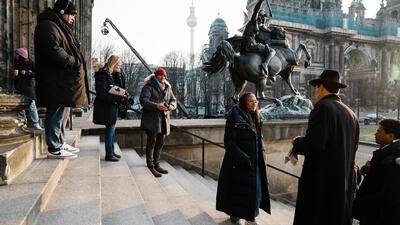This was your first time shooting on film, which is such a tactile thing. You get to watch rushes; editing is possibly different. What was that experience like for you?
Shooting on film, it really cemented my collaboration with my cinematographer Matthew Lloyd, which has become a relationship that looms large in my creative practice over the last three years. When I told him that I wanted to shoot on film for the very first time, he jumped into that wholeheartedly and assembled a crew of people and a workflow and a process that really allowed me, as someone who cut her teeth on digital filmmaking, to feel comfortable in a very uncomfortable process. I couldn’t see the images as they’re being rendered on screen onset. I had to trust that we got it. I was not able to see my dailies until the next day, if I’m lucky. When we were in India, it was a week later.
So it was a process of having to free myself from the certainty of what digital filmmaking allows me to do. And trust in my collaborators, collaborations that Matthew led. I loved it. I loved the way 16mm feels and looks and what it did to unify all of the different cultures and communities and timeframes in the movie. But also, I loved what the process did, in terms of the trust and relationship building with Matthew and myself. That was a real ride that I enjoyed.

This is such, as you said, a globe-trotting film. It’s epic in scale like the fantastical “A Wrinkle In Time,” but with even more locations and timelines that crisscross as the film progresses. How did you plan out your shoots at such a scale?
It was a thrill every day and a treat to put together as a big puzzle piece. My producing partner Paul Garnes, we’ve been together since my Sundance-winning film “Middle of Nowhere.” It’s been a long time. We’ve made “Middle of Nowhere, “Selma,” “Queen Sugar,” and many other TV shows that we produce under our banner Array. So, with “Origin,” all the things that we note we learned on all those projects came into play. We were able to set out to do something that we had never done. Yet it felt familiar, because we’ve produced together for so long. Also, without a studio, we didn’t have to wade through nos and maybes. We just did it. We’d say, “Let’s do it!” and then we went out and did it.

